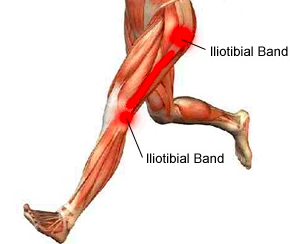Strength training for runners and endurance athletes

First of all, you can’t directly strengthen running or (other endurance/overuse injuries) to fix them. Although injuries can be created by weakness and imbalances, the injury itself can have inflammation, microtears, adhesions, scar tissue or muscle/tendon disrepair that often need rest (pain free stretching, mobility, cross training) or treatment. This is why, to treat these things, I and other sports-based practitioners use a combination of Active Release, Shockwave, Class 4 laser, Graston and Chiropractic to treat injuries BEFORE strengthening can help rebuild the actual injured area (typically involve tendons/fascia due to lower blood supply than muscles) to prevent the next injury.
When and why Strength training is MORE important that stretching:
a) running economy/performance/speed: less deviations, wasted movements and energy leaks
b) a higher percentage of endurance can be maintained relative to strength increase.
c) a natural increase in stride length (without excessive heel striking or overstriding or reduction in cadence)
d) protection of joints and tendon control (decrease in excessive range of motion in lateral and rotational planes)
e) provides stability at end ranges with helps with active flexibility more than passive stretching.
f) injury prevention due to better control and durability of eccentric muscle contraction (more damaging to muscles)
Quality vs. Quantity
1) 1x/week for heavy weights during a running/endurance program. Off or early season 1-2x/week depending on recovery and intensity (volume) of strength session and running schedule combined.
2) Focus on TUL (time under load or tension), ideally 45-60s rather than number of repetitions. This ensures a slow, controlled, continuous force to avoid breaks or ‘cheating’ through compensation by using other muscles, momentum and/or resting at the top or bottom of the exercise (that often occurs when a number of repetitions is the focus), OR, to reduce recovery time and focus on the nervous system, 3-5 reps with heavy loads (squat/hex bar deadlift etc.) with a quicker (safe) lowering of the weight to avoid the damage of the eccentric phases (more microtears)
3) Add a few explosive jumps (plyometrics), 5-6 is good, after or between strength exercises. Plyometrics help bridge the gap between strength training and running power. There is something called postactivation potentiation (PAP), (technically either from more sensitive Calcium channels or increase in synaptic transmission) that allows for an increase in jump height (should translate to stride length, increase wattage on the bike etc.) immediately following a strength exercise.
4) For lateral (running) stability of hip and leg, put a circular exercise band around your ankles during side-steps, side-squats, low-walking in different directions, planks with lateral leg movements etc.
5) For rotational (running) stability of hip and leg, put a circular exercise band around your knees during squats, squat jumps, single leg squats, side plank (with clam shells) etc.
6) Before switching from any exercise using continous tension, ideally complete 45-60 seconds close to momentary muscle failure (MMF) so that the body is forced to hyper compensate, rather than just trying to get out of breath with several insufficient (to create stimulus for change) strength exercises.
For example, the burpee (push-up followed by squat +/- jump, repeat): Rather than doing one push-up followed by one squat, separate them to get true muscle fatigue/breakdown necessary for adaptation. Do the push-up (any version (will good technique) that you can barely do 45-60 seconds), THEN switch to the squat and find a version (SL, only part way up, super-slow etc. that you can barely do for 45-60 seconds). Your cardiovascular system is better trained through repetitive big muscle exercises such as running, cycling, rowing, swimming that you are already doing and therefore no need to incorporate at the expense of strength during strength training. The adaptive ability of the muscles of the legs to quickly take the lactate and send it back to the liver to create more glucose (Cori cycle) and bring back to the muscle is shortchanged (not to mention all of the other metabolic adaptations occurring at the level of the muscle) by switching to a pushup or another exercise.
7) Once you can do an exercise for over 60+ seconds, make it harder somehow.
For example, if you can do a plank for 60 seconds (from knees or toes), instead of going longer, make it harder but lifting 1 arm or 1 leg or putting a circular band around your ankles and side-stepping back and forth, squeezing your quads, glutes, abs, pulling your elbows towards your toes etc.
Question:
Does this mean that (concurrent training) boot camps, high intensity classes or any regime that goes from one exercise to another is inefficient for distance athletes?
I don’t want to say they are inefficient, because it depends on your goals and current fitness level and how close your race or season that you are. Humans are extremely adaptive and will improve a lot with any training, especially at the start, as long as the intensity is sufficient.
However, since specificity is key and any time you sacrifice one goal, strength for example, by purposely adding heavy breathing by switching exercises (for ‘cardio’) before the key stimulus is there for strength gains/adaptations (recovery between sets, slow and/or controlled movements, momentary muscle exhaustion or failure (MMF) etc.) you are not hitting optimal levels. This variability typically does NOT challenge any one system sufficiently to force changes to your strength OR ‘cardiovascular’ system unless concurrent exercises fitness IS your goal.
The other key concept is that many of the cardiovascular benefits are maximized in the muscle itself, peripherally to the heart, including mitochondrial density, enzyme and vascular adaptions. This makes heart rate monitoring (central adaption) less relevant if the exercises (peripherally) are always changing.
We also now know that the heart can accumulate inflammation and scar tissue (cardiac fibrosis) if there are too many long hard cardio session over the months/years. Therefore, if we can be more specific and get them during less frequently running (sport specific) intervals instead/only, hopefully we can reduce the risk and increase the sport specific results.